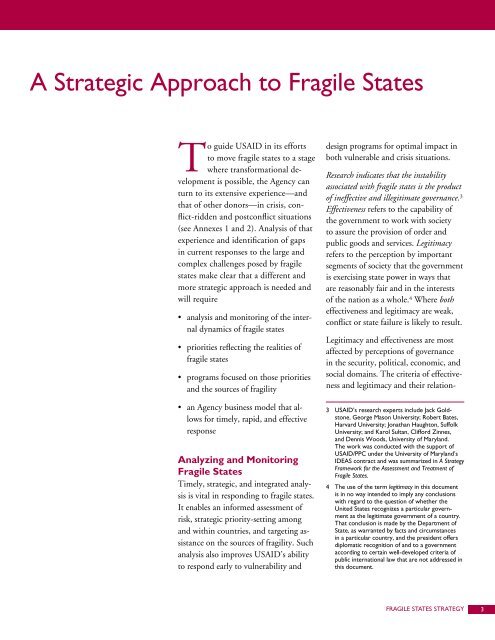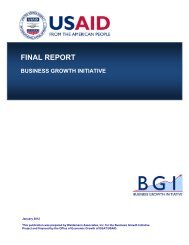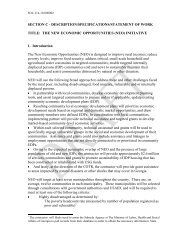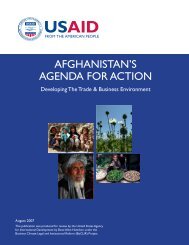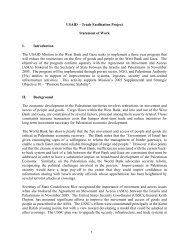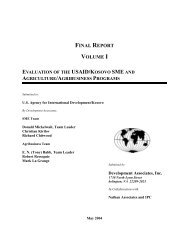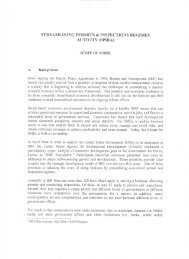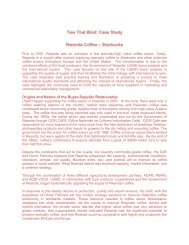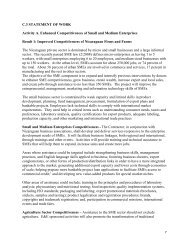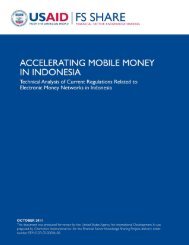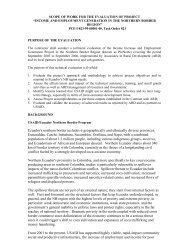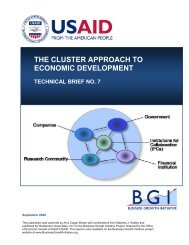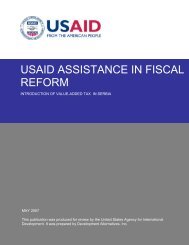suffering. <strong>The</strong> most significant shortfallsin meeting the widely supportedDevelopment Goals of the MillenniumDeclaration will likely be infragile states.• Third, there is a clear recognitionthat foreign assistance in the twentyfirstcentury needs to be more effectivelytailored to the context in whichit is being used, and that maximizingeffectiveness of assistance in fragilestates is an urgent challenge. 2This strategy lays out a vision for how<strong>USAID</strong> can most effectively respond tofragile states. <strong>The</strong> strategy’s overall goal isto guide <strong>USAID</strong>’s efforts in reversing declinein fragile states and advancing theirrecovery to a stage where transformationaldevelopment progress is possible.<strong>The</strong> strategy identifies the ways thatfragile states differ from those that arestable and able to pursue long-termdevelopment. It also identifies strategicpriorities for fragile states and initialdirections for <strong>USAID</strong> programming.Finally, the strategy focuses on managementand administrative changesneeded and outlines a new businessmodel for <strong>USAID</strong>’s operations infragile states.Due to the increasing importance ofimproving our approach to fragilestates, <strong>USAID</strong> is issuing two related2 See <strong>USAID</strong>’s White Paper: U.S. Foreign Aid:Meeting the Challenges of the Twenty-First Century(Washington, D.C., 2004). PD-ABZ-322. Thispaper identifies five core operational goals forforeign aid: promote transformational development,strengthen fragile states, provide humanitarianrelief, support strategic states, and addressglobal and transnational issues and other special,self-standing concerns. It calls for resources,results, and measures of aid effectiveness to bedifferentiated for each of these goals.<strong>The</strong> strategy’s overall goal is to guide <strong>USAID</strong>’s effortsin reversing decline in fragile states and advancing theirrecovery to a stage where transformational developmentprogress is possible.policies to address conflict and internallydisplaced persons (IDPs).Although conflict is not limited tofragile states, the propensity for a fragilestate to experience violent conflict ishigh. For that reason, the new conflictpolicy, and its accompanying tools,will be a critical part of this effort.Effectively addressing the complexchallenges of fragile states clearly goesfar beyond <strong>USAID</strong>. It will require a coordinatedU.S. Government approach,particularly in conflict situations, toensure that diplomatic, security, andmilitary efforts are mutually reinforcingand that <strong>USAID</strong>’s assets are integratedwith those of the departments of State,Defense, Treasury, Justice, and others.<strong>The</strong> recent creation of the Office of theCoordinator for Reconstruction andStabilization (S/CRS) at the Departmentof State is a strong indicator of theincreased understanding of the need fora more coordinated U.S. Governmentresponse to postconflict and stabilizationefforts.S/CRS was established to coordinatethe U.S. civilian response to countriesin conflict or civil strife. <strong>The</strong> office willfocus on improving civilian responsecapability and leading interagency teamsto initiate planning and response effortsin a limited number of crisis and postconflictcountries of national strategicinterest. <strong>USAID</strong> is working closely tosupport the new office with staff andtechnical expertise; the Agency is likelyto serve as a principal operational armfor the office and is also providing inputto its monitoring efforts. However,<strong>USAID</strong> will continue to focus on amuch broader spectrum of fragile states.In addition to stronger U.S. Governmentcoordination, close partnershipsand coordination with other donors andinternational organizations are essentialfor successfully responding to fragilestates. <strong>The</strong> United Nations and its specializedagencies, the World Bank, otherinternational organizations, and donorsall bring critical resources and perspectivesto bear on the challenges facingfragile states. When paired with thecommitment of local actors to addressthe sources of fragility, this coordinatedapproach stands the greatest chance ofmoving states forward and improvingprospects for long-term development.2 FRAGILE STATES STRATEGY
A Strategic Approach to <strong>Fragile</strong> <strong>States</strong>To guide <strong>USAID</strong> in its effortsto move fragile states to a stagewhere transformational developmentis possible, the Agency canturn to its extensive experience—andthat of other donors—in crisis, conflict-riddenand postconflict situations(see Annexes 1 and 2). Analysis of thatexperience and identification of gapsin current responses to the large andcomplex challenges posed by fragilestates make clear that a different andmore strategic approach is needed andwill require• analysis and monitoring of the internaldynamics of fragile states• priorities reflecting the realities offragile states• programs focused on those prioritiesand the sources of fragility• an Agency business model that allowsfor timely, rapid, and effectiveresponseAnalyzing and Monitoring<strong>Fragile</strong> <strong>States</strong>Timely, strategic, and integrated analysisis vital in responding to fragile states.It enables an informed assessment ofrisk, strategic priority-setting amongand within countries, and targeting assistanceon the sources of fragility. Suchanalysis also improves <strong>USAID</strong>’s abilityto respond early to vulnerability anddesign programs for optimal impact inboth vulnerable and crisis situations.Research indicates that the instabilityassociated with fragile states is the productof ineffective and illegitimate governance. 3Effectiveness refers to the capability ofthe government to work with societyto assure the provision of order andpublic goods and services. Legitimacyrefers to the perception by importantsegments of society that the governmentis exercising state power in ways thatare reasonably fair and in the interestsof the nation as a whole. 4 Where botheffectiveness and legitimacy are weak,conflict or state failure is likely to result.Legitimacy and effectiveness are mostaffected by perceptions of governancein the security, political, economic, andsocial domains. <strong>The</strong> criteria of effectivenessand legitimacy and their relation-3 <strong>USAID</strong>’s research experts include Jack Goldstone,George Mason <strong>University</strong>; Robert Bates,Harvard <strong>University</strong>; Jonathan Haughton, Suffolk<strong>University</strong>; and Karol Sultan, Clifford Zinnes,and Dennis Woods, <strong>University</strong> of Maryland.<strong>The</strong> work was conducted with the support of<strong>USAID</strong>/PPC under the <strong>University</strong> of Maryland’sIDEAS contract and was summarized in A <strong>Strategy</strong>Framework for the Assessment and Treatment of<strong>Fragile</strong> <strong>States</strong>.4 <strong>The</strong> use of the term legitimacy in this documentis in no way intended to imply any conclusionswith regard to the question of whether theUnited <strong>States</strong> recognizes a particular governmentas the legitimate government of a country.That conclusion is made by the Department ofState, as warranted by facts and circumstancesin a particular country, and the president offersdiplomatic recognition of and to a governmentaccording to certain well-developed criteria ofpublic international law that are not addressed inthis document.FRAGILE STATES STRATEGY 3


